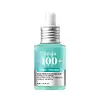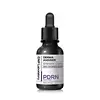What's inside
What's inside
 Key Ingredients
Key Ingredients

 Benefits
Benefits

 Concerns
Concerns

No concerns
 Ingredients Side-by-side
Ingredients Side-by-side

Water
Skin ConditioningButylene Glycol
HumectantPropanediol
SolventGlycerin
HumectantHydrolyzed Hyaluronic Acid
Humectant1,2-Hexanediol
Skin ConditioningNiacinamide
SmoothingGlyceryl Oleate
EmollientLauryl Glucoside
CleansingMyristyl Glucoside
CleansingPolyglyceryl-6 Laurate
EmulsifyingHydrogenated Lecithin
EmulsifyingGlutathione
Hydrolyzed Collagen
EmollientSodium Hyaluronate
HumectantCoptis Japonica Root Extract
Skin ConditioningAdenosine
Skin ConditioningMelia Azadirachta Leaf Extract
Skin ConditioningMelia Azadirachta Flower Extract
Skin ConditioningCoccinia Indica Fruit Extract
Skin ConditioningSodium Dna
Skin ConditioningSolanum Melongena Fruit Extract
Skin ConditioningHyaluronic Acid
HumectantHydrolyzed Sodium Hyaluronate
Skin ConditioningHydroxypropyltrimonium Hyaluronate
Potassium Hyaluronate
Skin ConditioningSodium Hyaluronate Crosspolymer
HumectantSodium Acetylated Hyaluronate
HumectantOcimum Sanctum Leaf Extract
Skin ConditioningCitric Acid
BufferingCurcuma Longa Root Extract
MaskingCorallina Officinalis Extract
Skin ConditioningSodium Citrate
BufferingPentylene Glycol
Skin ConditioningWater, Butylene Glycol, Propanediol, Glycerin, Hydrolyzed Hyaluronic Acid, 1,2-Hexanediol, Niacinamide, Glyceryl Oleate, Lauryl Glucoside, Myristyl Glucoside, Polyglyceryl-6 Laurate, Hydrogenated Lecithin, Glutathione, Hydrolyzed Collagen, Sodium Hyaluronate, Coptis Japonica Root Extract, Adenosine, Melia Azadirachta Leaf Extract, Melia Azadirachta Flower Extract, Coccinia Indica Fruit Extract, Sodium Dna, Solanum Melongena Fruit Extract, Hyaluronic Acid, Hydrolyzed Sodium Hyaluronate, Hydroxypropyltrimonium Hyaluronate, Potassium Hyaluronate, Sodium Hyaluronate Crosspolymer, Sodium Acetylated Hyaluronate, Ocimum Sanctum Leaf Extract, Citric Acid, Curcuma Longa Root Extract, Corallina Officinalis Extract, Sodium Citrate, Pentylene Glycol
Water
Skin ConditioningGlycerin
HumectantDipropylene Glycol
HumectantPEG/PPG/Polybutylene Glycol-8/5/3 Glycerin
HumectantNiacinamide
SmoothingBis-PEG-18 Methyl Ether Dimethyl Silane
EmollientButylene Glycol
Humectant1,2-Hexanediol
Skin ConditioningPEG-7 Glyceryl Cocoate
EmulsifyingDimethicone
EmollientBetaine
HumectantJojoba Wax PEG-120 Esters
Methylpropanediol
SolventPanthenol
Skin ConditioningPEG/PPG-17/6 Copolymer
SolventSodium Dna
Skin ConditioningLactobacillus Ferment Lysate
Skin ConditioningPolymethylsilsesquioxane
Triethylhexanoin
MaskingSodium Acrylate/Vinyl Alcohol Copolymer
Emulsion StabilisingHydrogenated Lecithin
EmulsifyingSodium Polyacrylate
AbsorbentLactobacillus/Soybean Ferment Extract
Skin ConditioningChondrus Crispus Extract
Skin ConditioningCeramide NP
Skin ConditioningAcrylates/C10-30 Alkyl Acrylate Crosspolymer
Emulsion StabilisingC14-22 Alcohols
Emulsion StabilisingSqualane
EmollientTromethamine
BufferingSaccharomyces/Potato Extract Ferment Filtrate
HumectantSodium Acrylic Acid/Ma Copolymer
Saccharomyces/Barley Seed Ferment Filtrate
HumectantSucrose Stearate
EmollientRosmarinus Officinalis Leaf Oil
MaskingC18-21 Alkane
SolventMacadamia Ternifolia Seed Oil
EmollientPolyglyceryl-10 Stearate
Skin ConditioningStearic Acid
CleansingPolyglyceryl-10 Oleate
Skin ConditioningGlyceryl Acrylate/Acrylic Acid Copolymer
HumectantAdenosine
Skin ConditioningArachidyl Glucoside
EmulsifyingButyrospermum Parkii Butter
Skin ConditioningTocopherol
AntioxidantPalmitic Acid
EmollientSalvia Sclarea Oil
MaskingSodium Hyaluronate
HumectantTrisodium EDTA
Glycine Soja Oil
EmollientTrideceth-6
EmulsifyingCholesterol
EmollientGlyceryl Stearate
EmollientTroxerutin
Skin ConditioningBeta-Glucan
Skin ConditioningCarbomer
Emulsion StabilisingPEG-100 Stearate
Arginine
MaskingGlutamic Acid
HumectantJuniperus Mexicana Oil
MaskingGlycosphingolipids
EmollientLinalool
PerfumingLimonene
PerfumingWater, Glycerin, Dipropylene Glycol, PEG/PPG/Polybutylene Glycol-8/5/3 Glycerin, Niacinamide, Bis-PEG-18 Methyl Ether Dimethyl Silane, Butylene Glycol, 1,2-Hexanediol, PEG-7 Glyceryl Cocoate, Dimethicone, Betaine, Jojoba Wax PEG-120 Esters, Methylpropanediol, Panthenol, PEG/PPG-17/6 Copolymer, Sodium Dna, Lactobacillus Ferment Lysate, Polymethylsilsesquioxane, Triethylhexanoin, Sodium Acrylate/Vinyl Alcohol Copolymer, Hydrogenated Lecithin, Sodium Polyacrylate, Lactobacillus/Soybean Ferment Extract, Chondrus Crispus Extract, Ceramide NP, Acrylates/C10-30 Alkyl Acrylate Crosspolymer, C14-22 Alcohols, Squalane, Tromethamine, Saccharomyces/Potato Extract Ferment Filtrate, Sodium Acrylic Acid/Ma Copolymer, Saccharomyces/Barley Seed Ferment Filtrate, Sucrose Stearate, Rosmarinus Officinalis Leaf Oil, C18-21 Alkane, Macadamia Ternifolia Seed Oil, Polyglyceryl-10 Stearate, Stearic Acid, Polyglyceryl-10 Oleate, Glyceryl Acrylate/Acrylic Acid Copolymer, Adenosine, Arachidyl Glucoside, Butyrospermum Parkii Butter, Tocopherol, Palmitic Acid, Salvia Sclarea Oil, Sodium Hyaluronate, Trisodium EDTA, Glycine Soja Oil, Trideceth-6, Cholesterol, Glyceryl Stearate, Troxerutin, Beta-Glucan, Carbomer, PEG-100 Stearate, Arginine, Glutamic Acid, Juniperus Mexicana Oil, Glycosphingolipids, Linalool, Limonene
 Reviews
Reviews

Ingredients Explained
These ingredients are found in both products.
Ingredients higher up in an ingredient list are typically present in a larger amount.
1,2-Hexanediol is a synthetic liquid and another multi-functional powerhouse.
It is a:
- Humectant, drawing moisture into the skin
- Emollient, helping to soften skin
- Solvent, dispersing and stabilizing formulas
- Preservative booster, enhancing the antimicrobial activity of other preservatives
Adenosine is in every living organism. It is one of four components in nucleic acids that helps store our DNA.
Adenosine has many benefits when used. These benefits include hydrating the skin, smoothing skin, and reducing wrinkles. Once applied, adenosine increases collagen production. It also helps with improving firmness and tissue repair.
Studies have found adenosine may also help with wound healing.
In skincare products, Adenosine is usually derived from yeast.
Learn more about AdenosineButylene Glycol (or BG) is used within cosmetic products for a few different reasons:
Overall, Butylene Glycol is a safe and well-rounded ingredient that works well with other ingredients.
Though this ingredient works well with most skin types, some people with sensitive skin may experience a reaction such as allergic rashes, closed comedones, or itchiness.
Learn more about Butylene GlycolGlycerin is already naturally found in your skin. It helps moisturize and protect your skin.
A study from 2016 found glycerin to be more effective as a humectant than AHAs and hyaluronic acid.
As a humectant, it helps the skin stay hydrated by pulling moisture to your skin. The low molecular weight of glycerin allows it to pull moisture into the deeper layers of your skin.
Hydrated skin improves your skin barrier; Your skin barrier helps protect against irritants and bacteria.
Glycerin has also been found to have antimicrobial and antiviral properties. Due to these properties, glycerin is often used in wound and burn treatments.
In cosmetics, glycerin is usually derived from plants such as soybean or palm. However, it can also be sourced from animals, such as tallow or animal fat.
This ingredient is organic, colorless, odorless, and non-toxic.
Glycerin is the name for this ingredient in American English. British English uses Glycerol/Glycerine.
Learn more about GlycerinHydrogenated Lecithin is created from the hydrogenation of lecithin (a group of phospholipids). Hydrogenation is a chemical reaction between hydrogen and another element.
This ingredient is an emollient and emulsifier. As an emollient, it helps soften skin by trapping moisture within. As an emulsifier, it prevents oil and water ingredients from separating.
Niacinamide is a multitasking form of vitamin B3 that strengthens the skin barrier, reduces pores and dark spots, regulates oil, and improves signs of aging.
And the best part? It's gentle and well-tolerated by most skin types, including sensitive and reactive skin.
You might have heard of "niacin flush", or the reddening of skin that causes itchiness. Niacinamide has not been found to cause this.
In very rare cases, some individuals may not be able to tolerate niacinamide at all or experience an allergic reaction to it.
If you are experiencing flaking, irritation, and dryness with this ingredient, be sure to double check all your products as this ingredient can be found in all categories of skincare.
When incorporating niacinamide into your routine, look out for concentration amounts. Typically, 5% niacinamide provides benefits such as fading dark spots. However, if you have sensitive skin, it is better to begin with a smaller concentration.
When you apply niacinamide to your skin, your body converts it into nicotinamide adenine dinucleotide (NAD). NAD is an essential coenzyme that is already found in your cells as "fuel" and powers countless biological processes.
In your skin, NAD helps repair cell damage, produce new healthy cells, support collagen production, strengthen the skin barrier, and fight environmental stressors (like UV and pollution).
Our natural NAD levels start to decline with age, leading to slower skin repair, visible aging, and a weaker skin barrier. By providing your skin niacinamide, you're recharging your skin's NAD levels. This leads to stronger, healthier, and younger looking skin.
Another name for vitamin B3 is nicotinamide. This vitamin is water-soluble and our bodies don't store it. We obtain Vitamin B3 from either food or skincare. Meat, fish, wheat, yeast, and leafy greens contain vitamin B3.
The type of niacinamide used in skincare is synthetically created.
Learn more about NiacinamideSodium DNA is an emerging anti-aging ingredient.
It is created by taking deoxyribonucleic acid (DNA) and purifying it with sodium hydroxide.
The DNA is extracted from several different animal sources, including: calf thymus, the gonadic tissue of a male sturgeon, or herring / salmon sperm.
You have probably seen this ingredient in anti-aging skincare. But what is it?
DNA is composed of nucleotides, or chemical building blocks. Nucleotides include adenine (A), thymine (T), guanine (G), and cytosine (C). Talk about a flashback to biology! Nucleosides are formed from these nucleotides.
The science behind Sodium DNA is based on an ingredient called Polydeoxyribonucleotide or PDRN.
PDRN are DNA fragments mainly extracted from the sperm cells of trout or salmon. Meaning, PDRN can be derived from Sodium DNA.
PDRN consists of chains of nucleotides and nucleosides mentioned above. They can range anywhere from 80 - 2000 pairs.
Studies show PDRN has the following properties:
Most of the research on PDRN has been done using injectable forms. That’s important, because PDRN is a large molecule and doesn’t absorb well through the skin. So if you’re applying it topically, the effects are likely to be much milder.
Still, topical Sodium DNA is emerging as a trendy anti-aging ingredient. It’s generally well-tolerated and offers good biocompatibility with human skin, making it a low-risk addition to most routines.
Further studies are needed to truly confirm this ingredients anti-aging ability (Remember, retinol has decades of research!).
When using this ingredient, is is best to ask a brand about the source of their Sodium DNA. You'll want to find products where the Sodium DNA is sourced from fish. Some Sodium DNA is derived from calf / cow thymus.
Needless to say, this ingredient is not vegan.
Learn more about Sodium DnaSodium Hyaluronate is hyaluronic acid's salt form. It is commonly derived from the sodium salt of hyaluronic acid.
Like hyaluronic acid, it is great at holding water and acts as a humectant. This makes it a great skin hydrating ingredient.
Sodium Hyaluronate is naturally occurring in our bodies and is mostly found in eye fluid and joints.
These are some other common types of Hyaluronic Acid:
Learn more about Sodium HyaluronateWater. It's the most common cosmetic ingredient of all. You'll usually see it at the top of ingredient lists, meaning that it makes up the largest part of the product.
So why is it so popular? Water most often acts as a solvent - this means that it helps dissolve other ingredients into the formulation.
You'll also recognize water as that liquid we all need to stay alive. If you see this, drink a glass of water. Stay hydrated!
Learn more about Water